初中英语语法专题-副词(附练习答案)
【英语】初中英语副词题20套(带答案)含解析

【英语】初中英语副词题20套(带答案)含解析一、初中英语副词1.—Could I speak to Paul? I phoned _____.—Sorry he is still in his meeting.A. lateB. earlierC. earliestD. later【答案】 B【解析】【分析】句意:——我能和保罗通话吗?我早些时候打电话来。
——对不起,他还在开会。
still仍然,根据对句 Sorry he is still in his meeting. 结合句意语境,可知打电话更早些,用副词比较级,故选B。
【点评】考查副词比较级辨析。
根据语境选出合适的选项,确保句子通顺。
2.I've read through this book several times,but I will read it so as to get better understanding.()A. more bravelyB. less eaiilyC. less confidentlyD. more carefully【答案】 D【解析】【分析】这本书我通读了几遍,但是为了获得更好的理解我将更认真地阅读一次.A.more bravely 更勇敢地;B.less easily不那么容易地;C.less confidently不那么自信地;D.more carefully更认真地,更仔细地.根据后文so as to get better understanding 给的目的,这里说的是更认真地,更仔细地.故选D.3.—Sarah is chosen as the guide for the Fashion Show.—Great! No one speaks English ________ her.A. as beautiful asB. as badly asC. worse thanD. better than【答案】 D【解析】【分析】句意:——Sarah被选为这次时尚表演的指导。
初中英语副词练习及答案

初中英语副词练习及答案【篇一:初中英语副词知识点及练习】副词和形容词一样,也有它的比较级和最高级形式. 可以参考形容词的变换形式。
但以词尾 -ly 结尾的副词(除 early )须用 more 和most 。
hard harder hardest fast fasterfastest earlyearlier earliest muchmore most warmlymore warmlymost warmly单音节副词的比较级是在副词后面加上 -er 构成的,最高级是在副词后面加上 -est 构成的。
near nearer nearest hard harder hardest 多音节副词的比较级是在副词的前面加上 -more 构成的。
最高级是在副词前面加上 -most 构成的。
warmly more warmly most warmlysuccessfully more successfully most successfully 有些副词的比较级和最高级形式是不规则的。
well-better - bestlittle - less - leastmuch- more - most badly - worse - worstfar-farther(further)-farthest(furthest)副词的比较级和最高级用法同形容词的比较级用法基本一样。
最高级形式句中 the 可以省略。
he works harder than i.他比我工作努力。
lucy gets up earlier than lili.露西比丽丽起床早。
he runs fastest in our class.他在我们班跑地最快。
he dives deeper than his teammates.他比他的队员潜水深。
its true that he speak english more fluently than any of us. 他英语讲的确实比我们任何人都好。
(英语)初中英语副词题20套(带答案)及解析
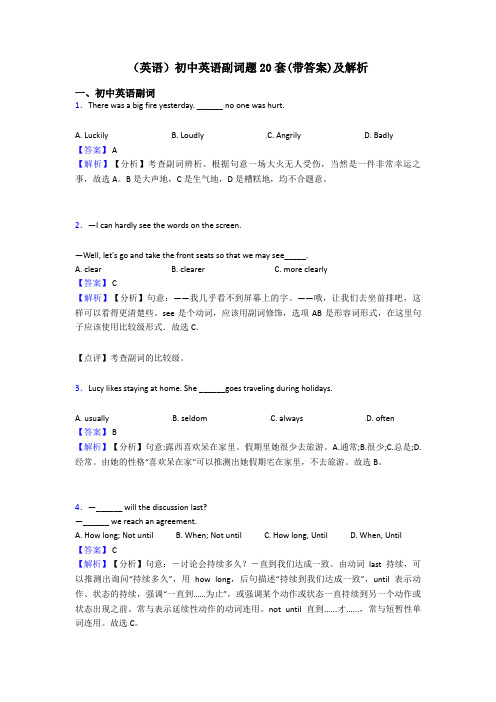
(英语)初中英语副词题20套(带答案)及解析一、初中英语副词1.There was a big fire yesterday. ______ no one was hurt.A. LuckilyB. LoudlyC. AngrilyD. Badly【答案】 A【解析】【分析】考查副词辨析。
根据句意一场大火无人受伤,当然是一件非常幸运之事,故选A。
B是大声地,C是生气地,D是糟糕地,均不合题意。
2.—I can hardly see the words on the screen.—Well, let's go and take the front seats so that we may see_____.A. clearB. clearerC. more clearly【答案】 C【解析】【分析】句意:——我几乎看不到屏幕上的字。
——哦,让我们去坐前排吧,这样可以看得更清楚些。
see是个动词,应该用副词修饰,选项AB是形容词形式,在这里句子应该使用比较级形式.故选C.【点评】考查副词的比较级。
3.Lucy likes staying at home. She ______goes traveling during holidays.A. usuallyB. seldomC. alwaysD. often【答案】 B【解析】【分析】句意:露西喜欢呆在家里。
假期里她很少去旅游。
A.通常;B.很少;C.总是;D.经常。
由她的性格“喜欢呆在家”可以推测出她假期宅在家里,不去旅游。
故选B。
4.—______ will the discussion last?—______ we reach an agreement.A. How long; Not untilB. When; Not untilC. How long, UntilD. When, Until【答案】 C【解析】【分析】句意:-讨论会持续多久?-直到我们达成一致。
【英语】英语副词专项训练100(附答案)及解析
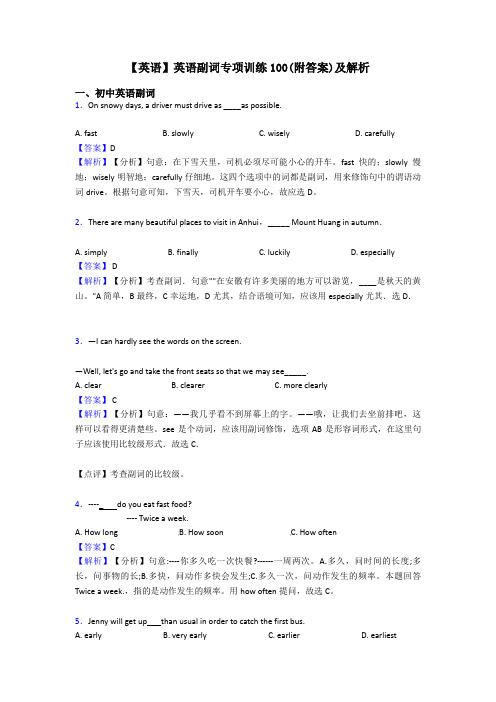
【英语】英语副词专项训练100(附答案)及解析一、初中英语副词1.On snowy days, a driver must drive as ____as possible.A. fastB. slowlyC. wiselyD. carefully【答案】D【解析】【分析】句意:在下雪天里,司机必须尽可能小心的开车。
fast快的;slowly慢地;wisely明智地;carefully仔细地。
这四个选项中的词都是副词,用来修饰句中的谓语动词drive。
根据句意可知,下雪天,司机开车要小心,故应选D。
2.There are many beautiful places to visit in Anhui,_____ Mount Huang in autumn.A. simplyB. finallyC. luckilyD. especially【答案】 D【解析】【分析】考查副词.句意""在安徽有许多美丽的地方可以游览,____是秋天的黄山。
"A简单,B最终,C幸运地,D尤其,结合语境可知,应该用especially尤其.选D.3.—I can hardly see the words on the screen.—Well, let's go and take the front seats so that we may see_____.A. clearB. clearerC. more clearly【答案】 C【解析】【分析】句意:——我几乎看不到屏幕上的字。
——哦,让我们去坐前排吧,这样可以看得更清楚些。
see是个动词,应该用副词修饰,选项AB是形容词形式,在这里句子应该使用比较级形式.故选C.【点评】考查副词的比较级。
4.----_ do you eat fast food?---- Twice a week.A. How longB. How soonC. How often【答案】C【解析】【分析】句意:----你多久吃一次快餐?------一周两次。
初中英语副词专项训练100(附答案)
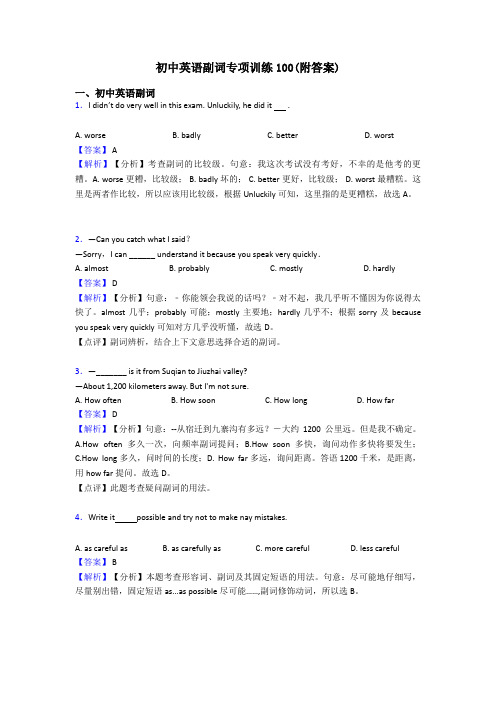
初中英语副词专项训练100(附答案)一、初中英语副词1.I didn’t do very well in this exam. Unluckily, he did it .A. worseB. badlyC. betterD. worst【答案】 A【解析】【分析】考查副词的比较级。
句意:我这次考试没有考好,不幸的是他考的更糟。
A. worse更糟,比较级; B. badly坏的; C. better更好,比较级; D. worst最糟糕。
这里是两者作比较,所以应该用比较级,根据Unluckily可知,这里指的是更糟糕,故选A。
2.—Can you catch what I said?—Sorry,I can ______ understand it because you speak very quickly.A. almostB. probablyC. mostlyD. hardly【答案】 D【解析】【分析】句意:﹣你能领会我说的话吗?﹣对不起,我几乎听不懂因为你说得太快了。
almost几乎;probably可能;mostly主要地;hardly几乎不;根据sorry及because you speak very quickly可知对方几乎没听懂,故选D。
【点评】副词辨析,结合上下文意思选择合适的副词。
3.—_______ is it from Suqian to Jiuzhai valley?—About 1,200 kilometers away. But I'm not sure.A. How oftenB. How soonC. How longD. How far【答案】 D【解析】【分析】句意:--从宿迁到九寨沟有多远?-大约1200公里远。
但是我不确定。
A.How often多久一次,向频率副词提问;B.How soon多快,询问动作多快将要发生;C.How long多久,问时间的长度;D. How far多远,询问距离。
(专题精选)初中英语语法知识—副词的全集汇编附答案
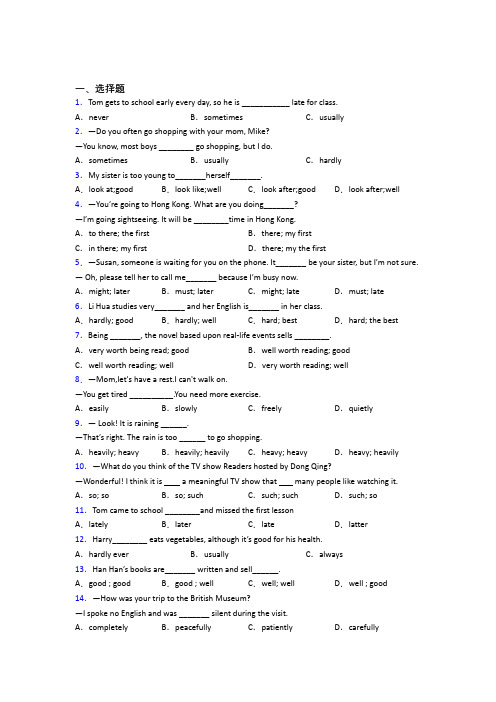
一、选择题1.Tom gets to school early every day, so he is ___________ late for class.A.never B.sometimes C.usually2.—Do you often go shopping with your mom, Mike?—You know, most boys ________ go shopping, but I do.A.sometimes B.usually C.hardly3.My sister is too young to_______herself_______.A.look at;good B.look like;well C.look after;good D.look after;well 4.—You’re going to Hong Kong. What are you doing_______?—I’m going sightseeing. It will be ________time in Hong Kong.A.to there; the first B.there; my firstC.in there; my first D.there; my the first5.—Susan, someone is waiting for you on the phone. It_______ be your sister, but I’m not sure.—Oh, please tell her to call me_______ because I’m busy now.A.might; later B.must; later C.might; late D.must; late6.Li Hua studies very_______ and her English is_______ in her class.A.hardly; good B.hardly; well C.hard; best D.hard; the best 7.Being _______, the novel based upon real-life events sells ________.A.very worth being read; good B.well worth reading; goodC.well worth reading; well D.very worth reading; well8.—Mom,let's have a rest.I can't walk on.—You get tired __________.You need more exercise.A.easily B.slowly C.freely D.quietly9.— Look! It is raining ______.—That’s right. The rain is t oo ______ to go shopping.A.heavily; heavy B.heavily; heavily C.heavy; heavy D.heavy; heavily 10.―What do you think of the TV show Readers hosted by Dong Qing?―Wonderful! I think it is a meaningful TV show that many people like watching it. A.so; so B.so; such C.such; such D.such; so 11.Tom came to school ________and missed the first lessonA.lately B.later C.late D.latter12.Harry________ eats vegetables, although it’s good for his health.A.hardly ever B.usually C.always13.Han Han’s boo ks are_______ written and sell______.A.good ; good B.good ; well C.well; well D.well ; good 14.—How was your trip to the British Museum?—I spoke no English and was _______ silent during the visit.A.completely B.peacefully C.patiently D.carefully15.—Why did you buy one more tie?you have got more than ten ties.—A man can never have _____ many ties.A.enough B.too C.so D.such 16.— Is your home close to the school, Tom?— No, it's a long way, but I am________ late for school because I get up early daily. A.always B.usually C.never D.sometimes 17.Amy makes fewer mistakes than Frank. She does her homework .A.more careless B.more carelessly C.more careful D.more carefully 18.I did in last English exam and I hardly made mistakes.A.enough well B.good enough C.enough good D.well enough 19.Lin Tao has a room, but it's not tidy. His toys are________ .A.here B.there C.everywhere 20.—Jack, how was your summer vacation?—Just so-so. I decided to go for my next vacation.A.something wonderful B.wonderful something C.somewhere wonderful D.wonderful somewhere21.— He studies late every day and goes to bed before twelve o’clock.—That’s bad for his health.A.always B.just C.already D.hardly 22.—Hi, Bob! I can’t find my story book. Have you seen it?—Sorry, I haven’t. Why not ask Jim? Perhaps he’s seen it _____.A.anywhere B.everywhere C.nowhere D.somewhere 23.—Why do you think Sam did _______ than anyone else in the competition?—Because he sang most loudly and _______.A.worse; carefully B.better; clearlyC.worse; quietly D.best; carefully24.The children are making too much __________. How __________ they are playing! A.noise; noisily B.noise; noisy C.noisy; noisy D.noisy; noisily 25.Millie is good at singing .She sings________the famous singer CoCo.A.as good as B.as the best as C.as well as D.as better as 【参考答案】***试卷处理标记,请不要删除一、选择题1.A解析:A【解析】【详解】句意:汤姆每天上学很早,所以上课从不迟到。
(英语)英语副词题20套(带答案)及解析

(英语)英语副词题20套(带答案)及解析一、初中英语副词1.—Joan has made great progress in speaking Chinese.—She_________works hard at it, you know.A. neverB. seldomC. always【答案】 C【解析】【分析】句意:——Joan在讲中文方面取得了很大进步。
——他一直很努力的学习,你知道的。
never从不;seldom很少;不常;always总是;一直;根据上一句“取得很大进步”可知“一直很努力”,故选C。
【点评】考查频度副词。
2.—The fish tastes _______, we have eaten it up.—It is certain that she cooked it _________.A. good , wellB. well, goodC. well, wellD. good, good 【答案】 A【解析】【分析】句意:一鱼尝起来不错。
我们把它吃光了。
一肯定她煮得好。
taste尝起来,是连系动词,连系动词后用形容词作表语,cook是行为动词,修饰行为动词要用副词形式。
good只是形容词,well作为形容词仅指“身体好”,同时well还是副词。
故选A。
3.—I can hardly see the words on the screen.—Well, let's go and take the front seats so that we may see_____.A. clearB. clearerC. more clearly【答案】 C【解析】【分析】句意:——我几乎看不到屏幕上的字。
——哦,让我们去坐前排吧,这样可以看得更清楚些。
see是个动词,应该用副词修饰,选项AB是形容词形式,在这里句子应该使用比较级形式.故选C.【点评】考查副词的比较级。
4.—Have you seen the hot film Wandering Earth ________?—Yes, I have. ________ wonderful science fiction movie it is!A. yet; How aB. already; HowC. yet; What aD. already; What 【答案】 C【解析】【分析】句意:——你曾经看过电影《流浪地球》吗?——是的,我已经看过了。
初中英语副词试题(有答案和解析)含解析
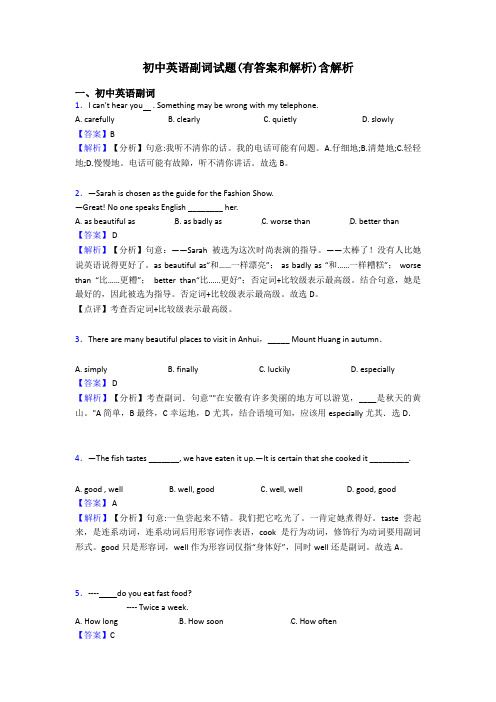
初中英语副词试题(有答案和解析)含解析一、初中英语副词1.I can't hear you . Something may be wrong with my telephone.A. carefullyB. clearlyC. quietlyD. slowly【答案】B【解析】【分析】句意:我听不清你的话。
我的电话可能有问题。
A.仔细地;B.清楚地;C.轻轻地;D.慢慢地。
电话可能有故障,听不清你讲话。
故选B。
2.—Sarah is chosen as the guide for the Fashion Show.—Great! No one speaks English ________ her.A. as beautiful asB. as badly asC. worse thanD. better than【答案】 D【解析】【分析】句意:——Sarah被选为这次时尚表演的指导。
——太棒了!没有人比她说英语说得更好了。
as beautiful as“和……一样漂亮”;as badly as “和……一样糟糕”; worse than “比……更糟”;better than“比……更好”;否定词+比较级表示最高级。
结合句意,她是最好的,因此被选为指导。
否定词+比较级表示最高级。
故选D。
【点评】考查否定词+比较级表示最高级。
3.There are many beautiful places to visit in Anhui,_____ Mount Huang in autumn.A. simplyB. finallyC. luckilyD. especially【答案】 D【解析】【分析】考查副词.句意""在安徽有许多美丽的地方可以游览,____是秋天的黄山。
"A简单,B最终,C幸运地,D尤其,结合语境可知,应该用especially尤其.选D.4.—The fish tastes _______, we have eaten it up.—It is certain that she cooked it _________.A. good , wellB. well, goodC. well, wellD. good, good【答案】 A【解析】【分析】句意:一鱼尝起来不错。
副词用法试题及答案初中

副词用法试题及答案初中一、选择题(每题2分,共20分)1. 他总是第一个到达学校。
A. alwaysB. firstC. quicklyD. quietly答案:A2. 她经常在图书馆里看书。
A. alwaysB. oftenC. sometimesD. never答案:B3. 他们慢慢地走着。
A. quicklyB. slowlyC. fastD. slowly答案:B4. 他大声地唱歌。
A. loudlyB. quietlyC. softlyD. clearly答案:A5. 她经常在周末去购物。
A. alwaysB. oftenC. sometimesD. never答案:B6. 他快速地完成了作业。
A. slowlyB. quicklyC. fastD. slowly答案:B7. 她轻轻地敲门。
A. loudlyB. quietlyC. softlyD. clearly答案:C8. 他经常在晚上看电视。
A. alwaysB. oftenC. sometimesD. never答案:B9. 他们兴奋地谈论着。
A. excitedlyB. sadlyC. happilyD. angrily答案:A10. 他经常在周末去公园。
A. alwaysB. oftenC. sometimesD. never答案:B二、填空题(每题2分,共20分)1. 他_____(经常)去游泳。
答案:often2. 她_____(总是)按时完成作业。
答案:always3. 他们_____(快速地)跑向终点。
答案:quickly4. 他_____(大声地)朗读课文。
答案:loudly5. 她_____(轻轻地)关上门。
答案:softly6. 他_____(经常)在图书馆学习。
答案:often7. 他们_____(慢慢地)跳舞。
答案:slowly8. 她_____(兴奋地)接受了邀请。
答案:excitedly9. 他_____(安静地)坐在角落里。
(英语)初中英语副词专项训练100(附答案)及解析
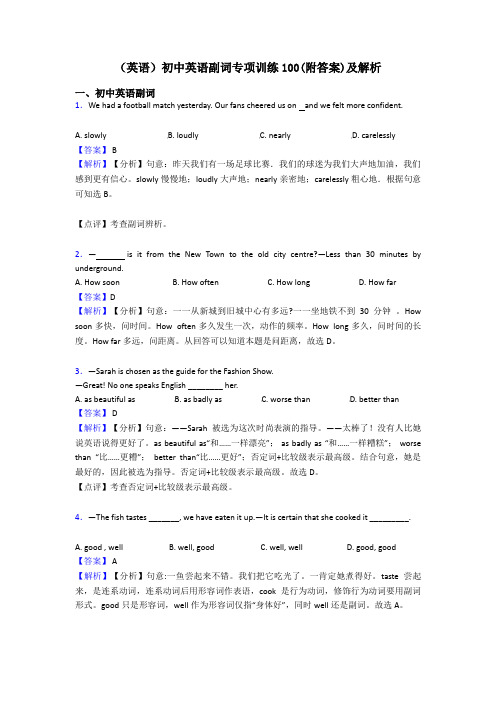
(英语)初中英语副词专项训练100(附答案)及解析一、初中英语副词1.We had a football match yesterday. Our fans cheered us on and we felt more confident.A. slowlyB. loudlyC. nearlyD. carelessly【答案】 B【解析】【分析】句意:昨天我们有一场足球比赛.我们的球迷为我们大声地加油,我们感到更有信心。
slowly慢慢地;loudly大声地;nearly亲密地;carelessly粗心地.根据句意可知选B。
【点评】考查副词辨析。
2.— is it from the New Town to the old city centre?—Less than 30 minutes by underground.A. How soonB. How oftenC. How longD. How far【答案】D【解析】【分析】句意:一一从新城到旧城中心有多远?一一坐地铁不到30分钟。
How soon多快,问时间。
How often多久发生一次,动作的频率。
How long多久,问时间的长度。
How far多远,问距离。
从回答可以知道本题是问距离,故选D。
3.—Sarah is chosen as the guide for the Fashion Show.—Great! No one speaks English ________ her.A. as beautiful asB. as badly asC. worse thanD. better than【答案】 D【解析】【分析】句意:——Sarah被选为这次时尚表演的指导。
——太棒了!没有人比她说英语说得更好了。
as beautiful as“和……一样漂亮”;as badly as “和……一样糟糕”; worse than “比……更糟”;better than“比……更好”;否定词+比较级表示最高级。
初中英语副词专项练习及答案
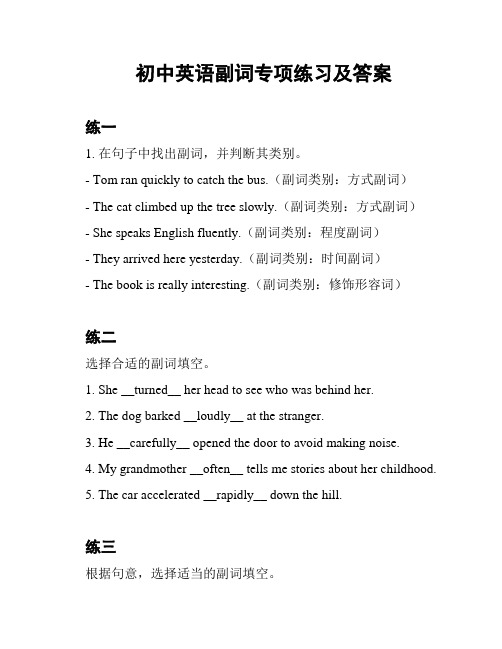
初中英语副词专项练习及答案练一1. 在句子中找出副词,并判断其类别。
- Tom ran quickly to catch the bus.(副词类别:方式副词)- The cat climbed up the tree slowly.(副词类别:方式副词)- She speaks English fluently.(副词类别:程度副词)- They arrived here yesterday.(副词类别:时间副词)- The book is really interesting.(副词类别:修饰形容词)练二选择合适的副词填空。
1. She __turned__ her head to see who was behind her.2. The dog barked __loudly__ at the stranger.3. He __carefully__ opened the door to avoid making noise.4. My grandmother __often__ tells me stories about her childhood.5. The car accelerated __rapidly__ down the hill.练三根据句意,选择适当的副词填空。
1. The little girl danced __gracefully__ on the stage.2. He __always__ arrives late for class.3. She answered the question __correctly__.4. The dog barked __loudly__ to scare away the intruder.5. We walked __quickly__ to catch the last train.答案练一1. quickly(方式副词)2. slowly(方式副词)3. fluently(程度副词)4. yesterday(时间副词)5. really(修饰形容词)练二1. turned2. loudly3. carefully4. often5. rapidly练三1. gracefully2. always3. correctly4. loudly5. quickly。
(英语)副词练习题含答案含解析
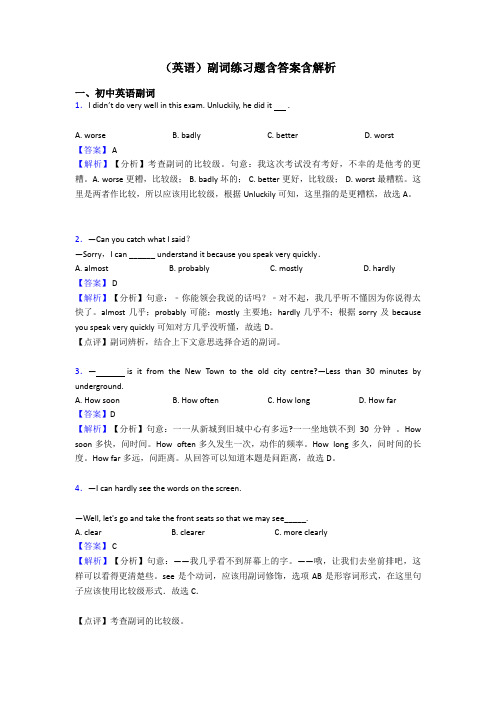
(英语)副词练习题含答案含解析一、初中英语副词1.I didn’t do very well in this exam. Unluckily, he did it .A. worseB. badlyC. betterD. worst【答案】 A【解析】【分析】考查副词的比较级。
句意:我这次考试没有考好,不幸的是他考的更糟。
A. worse更糟,比较级; B. badly坏的; C. better更好,比较级; D. worst最糟糕。
这里是两者作比较,所以应该用比较级,根据Unluckily可知,这里指的是更糟糕,故选A。
2.—Can you catch what I said?—Sorry,I can ______ understand it because you speak very quickly.A. almostB. probablyC. mostlyD. hardly【答案】 D【解析】【分析】句意:﹣你能领会我说的话吗?﹣对不起,我几乎听不懂因为你说得太快了。
almost几乎;probably可能;mostly主要地;hardly几乎不;根据sorry及because you speak very quickly可知对方几乎没听懂,故选D。
【点评】副词辨析,结合上下文意思选择合适的副词。
3.— is it from the New Town to the old city centre?—Less than 30 minutes by underground.A. How soonB. How oftenC. How longD. How far【答案】D【解析】【分析】句意:一一从新城到旧城中心有多远?一一坐地铁不到30分钟。
How soon多快,问时间。
How often多久发生一次,动作的频率。
How long多久,问时间的长度。
How far多远,问距离。
从回答可以知道本题是问距离,故选D。
(英语) 初中英语副词试题(有答案和解析)含解析
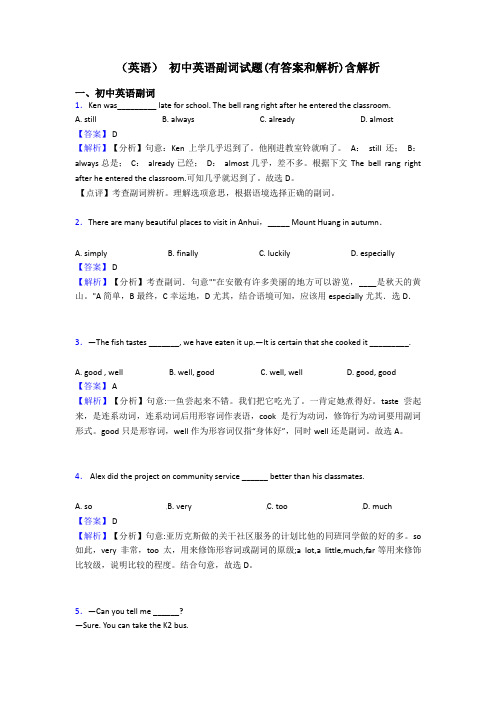
(英语)初中英语副词试题(有答案和解析)含解析一、初中英语副词1.Ken was_________ late for school. The bell rang right after he entered the classroom.A. stillB. alwaysC. alreadyD. almost【答案】 D【解析】【分析】句意:Ken上学几乎迟到了。
他刚进教室铃就响了。
A:still还;B:always总是;C:already已经;D:almost几乎,差不多。
根据下文The bell rang right after he entered the classroom.可知几乎就迟到了。
故选D。
【点评】考查副词辨析。
理解选项意思,根据语境选择正确的副词。
2.There are many beautiful places to visit in Anhui,_____ Mount Huang in autumn.A. simplyB. finallyC. luckilyD. especially【答案】 D【解析】【分析】考查副词.句意""在安徽有许多美丽的地方可以游览,____是秋天的黄山。
"A简单,B最终,C幸运地,D尤其,结合语境可知,应该用especially尤其.选D.3.—The fish tastes _______, we have eaten it up.—It is certain that she cooked it _________.A. good , wellB. well, goodC. well, wellD. good, good【答案】 A【解析】【分析】句意:一鱼尝起来不错。
我们把它吃光了。
一肯定她煮得好。
taste尝起来,是连系动词,连系动词后用形容词作表语,cook是行为动词,修饰行为动词要用副词形式。
good只是形容词,well作为形容词仅指“身体好”,同时well还是副词。
初中英语语法专题-副词(附练习答案)

副词第一节副词概述1.副词用于修饰动词、形容词、副词或整个句子(1)修饰动词:He walks fast.You must act quickly.Quick和fast的联系和区别: fast 与quick 两者都表示"快的",但有不同之处。
(1)fast多指运动物体速度"快",强调物体运动的方式, 既能用作形容词,又能用作副词,与quickly的含义比较接近,但它比较侧重于强调过程的迅速、快。
如:Lucy runs faster than Meimei. 露西跑得比梅梅快。
(2)quick多指动作发生或完成得很迅速、敏捷,强调动作的短暂性, 强调动作迅速发生并完成。
如:Come quick! 快一点来!Be quick! 快点。
He is quick at learning. 他学得快。
Don''''t talk so quick. We can''''t write down the main points. 不要讲这么快,我们没法把要点记下来。
另外,quickly是副词,也表示即刻行动,毫不迟延,指动作在较短的时间内或较近的将来即可发生或完成。
如:He quickly picks up the wallet on the ground. 他很快地拾起地上的钱夹。
(2)修饰形容词She is very beautiful.It’s pretty hot.(3)修饰副词Andy speaks French very well.Jack studies really hard.(4)修饰整句Luckily, we are all safe.Generally, men are stronger than women.2.副词的分类第二节副词的构成和比较等级1.形容词构成副词的一般规则有些形容词和副词同形,如:back adj. 后面的back adv. 向后地2.副词的比较等级(1)单音节词,加-er和-est(2)双音节词及多音节词,加more 和most但是early 的比较级和最高级则分别为:earlier earliest (3)不规则变化的词farther/ farthest, further /furthest的用法farther/ farthest和further /furthest都可用于表示距离和时间上的远We can go farther/further.We can look back farther/further into the past to find the truth. further /furthest 还可表示程度上的“深远”“进一步”The police will research further into this matter.3.原级比较常用句型……as+副词原级+as….该句型表示:….和…..一样He speaks as loudly as you do.….not as (so)+副词原级+as...该句型表示:…..不如…..I can’t walk as/so fast as you.他没有你反应的快。
副词(单选题 30题 含解析)初中英语专题练习
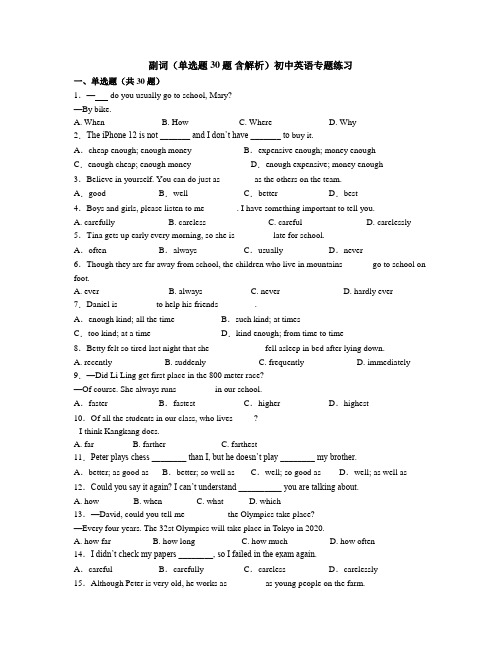
副词(单选题 30题含解析)初中英语专题练习一、单选题(共30题)1.— do you usually go to school, Mary?—By bike.A. WhenB. HowC. WhereD. Why2.The iPhone 12 is not _______ and I don’t have _______ to buy it.A.cheap enough; enough money B.expensive enough; money enough C.enough cheap; enough money D.enough expensive; money enough 3.Believe in yourself. You can do just as _______ as the others on the team.A.good B.well C.better D.best4.Boys and girls, please listen to me _______. I have something important to tell you.A. carefullyB. carelessC. carefulD. carelessly 5.Tina gets up early every morning, so she is ________ late for school.A.often B.always C.usually D.never6.Though they are far away from school, the children who live in mountains ______ go to school on foot.A. everB. alwaysC. neverD. hardly ever 7.Daniel is ________ to help his friends ________.A.enough kind; all the time B.such kind; at timesC.too kind; at a time D.kind enough; from time to time8.Betty felt so tired last night that she ____________ fell asleep in bed after lying down. A. recently B. suddenly C. frequently D. immediately 9.—Did Li Ling get first place in the 800 meter race?—Of course. She always runs ________ in our school.A.faster B.fastest C.higher D.highest10.Of all the students in our class, who lives_____?--I think Kangkang does.A. farB. fartherC. farthest11.Peter plays chess ________ than I, but he doesn’t play ________ my brother.A.better; as good as B.better; so well as C.well; so good as D.well; as well as 12.Could you say it again? I can’t understand __________ you are talking about.A. howB. whenC. whatD. which13.—David, could you tell me _________ the Olympics take place?—Every four years. The 32st Olympics will take place in Tokyo in 2020.A. how farB. how longC. how muchD. how often14.I didn’t check my papers ________, so I failed in the exam again.A.careful B.carefully C.careless D.carelessly 15.Although Peter is very old, he works as ________ as young people on the farm.A.hard B.harder C.hardest D.the hardest16.— ________ have you been in Jinan?— Since 2008.A. How longB. How oftenC. How soonD. How far17.I enjoy reading very much. When I read books, I feel that time goes .A. slowlyB. quicklyC. luckilyD. early18.Look, _________ they are listening to the teacher!A.how careful B.what careful C.how carefully D.what carefully19.________, the Internet was only used by the government. But now it’s widely used in every field.A. As usualB. At firstC. After allD. So far20.—Look at the bird over there! It’s so beautiful!—Wow! It’s a rare crane. It appears in this area.A. alwaysB. usuallyC. seldomD. often21.The 3-month-old baby cried from time to time last night. His parents had a good sleep.A. mostlyB. hardlyC. nearlyD. always22.As a member of the Wild Animals Club, he ____ buys furs.A. usuallyB. sometimesC. oftenD. never23.---Do you often go swimming in summer?---No, _________.Swimming is a good kind of sports, but I can’t swim.A. sometimesB. oftenC. alwaysD. never24.----How often were you late for school last term. Lisa?---- _______. I got to school early every day.A. AlwaysB. usuallyC. SometimesD. Never25.––Have you returned the book to the library _______?––Yes, I have _________ returned it.A. yet, yetB. already, alreadyC. already, yetD. yet, already26.Helen was so excited at the good news that she could ________ say a word.A.probably B.hardly C.suddenly D.immediately27.If you don’t push yourself, you will ________ know how amazing you can be!A.always B.usually C.sometimes D.never28.—Linda seldom makes mistakes in doing her homework.—I think so. Of all the friends, she does everything ________.A.carefully B.more carefully C.most carefully29.—Is your father strict with you?—Yes. He takes my grades as ________ as my teachers do.A.seriously B.serious C.more serious D.more seriously 30.—Wait for me, mom. I need to find what to wear first.—But you must do it as ________ as possible now. The concert will begin in 10 minutes.A.quick B.quicker C.quickly D.more quickly【参考答案】一、单选题(共30题)1.B【解析】句意:——玛丽你通常如何去上学?——骑车。
初中英语之副词及其练习(附答案)
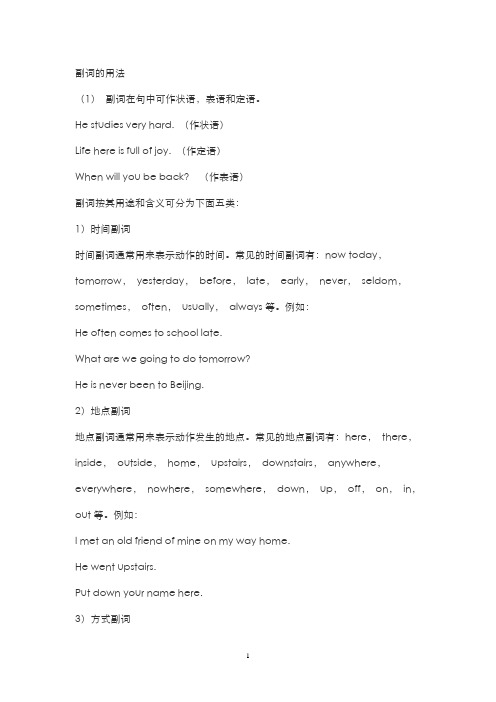
副词的用法(1)副词在句中可作状语,表语和定语。
He studies very hard. (作状语)Life here is full of joy. (作定语)When will you be back?(作表语)副词按其用途和含义可分为下面五类:1)时间副词时间副词通常用来表示动作的时间。
常见的时间副词有:now today,tomorrow,yesterday,before,late,early,never,seldom,sometimes,often,usually,always等。
例如:He often comes to school late.What are we going to do tomorrow?He is never been to Beijing.2)地点副词地点副词通常用来表示动作发生的地点。
常见的地点副词有:here,there,inside,outside,home,upstairs,downstairs,anywhere,everywhere,nowhere,somewhere,down,up,off,on,in,out等。
例如:I met an old friend of mine on my way home.He went upstairs.Put down your name here.3)方式副词方式副词一般都是回答“怎样的?”这类问题的,其中绝大部分都是由一个形容词加词尾-ly构成的,有少数方式副词不带词尾-ly,它们与形容词同形。
常见的方式副词有:anxiously,badly,bravely,calmly,carefully,proudly,rapidly,suddenly,successfully,angrily,happily,slowly,warmly,well,fast,slow,quick,hard,alone,high,straight,wide等。
(英语)英语副词专项训练及答案及解析

(英语)英语副词专项训练及答案及解析一、初中英语副词1. It is a world of flowers in spring in Dongying. You can see flowers .A. hereB. thereC. somewhereD. everywhere【答案】 D【解析】【分析】句意:春天东营就是一个花的世界,到处你都可以看到花。
here这儿;there那儿;somewhere某个地方;everywhere每个地方,到处。
根据句意可知,春天的东营是花的世界,因此处处都可以看到花,故选D。
2.Write it possible and try not to make nay mistakes.A. as careful asB. as carefully asC. more carefulD. less careful【答案】 B【解析】【分析】本题考查形容词、副词及其固定短语的用法。
句意:尽可能地仔细写,尽量别出错,固定短语as...as possible尽可能……,副词修饰动词,所以选B。
3.—Have you seen the hot film Wandering Earth ________?—Yes, I have. ________ wonderful science fiction movie it is!A. yet; How aB. already; HowC. yet; What aD. already; What 【答案】 C【解析】【分析】句意:——你曾经看过电影《流浪地球》吗?——是的,我已经看过了。
它是一个多么好的科幻小说电影啊!yet用在现在完成时的疑问句或者否定句,already 用在肯定句,句子是一般疑问句,所以用yet。
what引导的感叹句结构是What+a/an+形容词+可数名词单数+主语+谓语!how引导的感叹句结构是How+形容词或者副词+主语+谓语!,这里强调名词movie,所以用what a,故选C。
初二英语副词特殊用法练习题20题(带答案)

初二英语副词特殊用法练习题20题(带答案)1.He runs very _____.A.quickB.quicklyC.slowD.slowly答案解析:B。
quick 和slow 是形容词,不能修饰动词runs。
quickly 和slowly 是副词,quickly 表示快速地,slowly 表示缓慢地。
根据语境,应该选择quickly,表示他跑得非常快。
2.She speaks English _____.A.goodB.wellC.badD.badly答案解析:B。
good 和bad 是形容词,不能修饰动词speaks。
well 和badly 是副词,well 表示好地,badly 表示坏地。
根据语境,应该选择well,表示她英语说得好。
3.The boy is _____ tall.A.veryB.tooC.soD.enough答案解析:A。
very 可以修饰形容词tall,表示非常高。
too 表示太,通常用于“too...to...”结构,表示太……而不能……。
so 通常用于“so...that...”结构,表示如此……以至于……。
enough 修饰形容词时要放在形容词后面。
根据语境,应该选择very。
4.The weather is _____ cold today.A.reallyB.very muchC.quiteD.too much答案解析:A。
very much 通常修饰动词,不能修饰形容词cold。
too much 修饰不可数名词,不能修饰形容词。
quite 和really 都可以修饰形容词,但quite 通常用于肯定句,really 更通用。
根据语境,应该选择really。
5.He works _____ hard.A.veryB.reallyC.extremelyD.too答案解析:C。
very 和really 都比较常用,但extremely 表示极其,程度更深。
too 表示太,通常用于否定句或“too...to...”结构。
七年级英语副词练习题50题答案解析版

七年级英语副词练习题50题答案解析版1.He ______ goes to school by bike.A.alwaysB.sometimesC.neverD.hardly ever答案解析:A。
“always”表示总是,符合语境。
“sometimes”表示有时;“never”表示从不;“hardly ever”表示几乎不。
本题根据语境可知是强调经常发生的动作,所以选“always”。
2.She is ______ late for school.A.alwaysB.sometimesC.neverD.often答案解析:C。
“never”表示从不,符合语境。
“always”表示总是;“sometimes”表示有时;“often”表示经常。
根据常理,不应该迟到,所以选“never”。
3.My brother ______ plays basketball after school.A.sometimesB.alwaysC.neverD.hardly ever答案解析:B。
“always”表示总是,符合语境。
“sometimes”表示有时;“never”表示从不;“hardly ever”表示几乎不。
根据语境可知哥哥经常放学后打篮球,所以选“always”。
4.I ______ read books in my free time.A.oftenB.sometimesC.alwaysD.never答案解析:A。
“often”表示经常,符合语境。
“sometimes”表示有时;“always”表示总是;“never”表示从不。
根据常理,在空闲时间经常读书比较合理,所以选“often”。
5.They ______ watch TV in the evening.A.sometimesB.alwaysC.neverD.often答案解析:D。
“often”表示经常,符合语境。
“sometimes”表示有时;“always”表示总是;“never”表示从不。
- 1、下载文档前请自行甄别文档内容的完整性,平台不提供额外的编辑、内容补充、找答案等附加服务。
- 2、"仅部分预览"的文档,不可在线预览部分如存在完整性等问题,可反馈申请退款(可完整预览的文档不适用该条件!)。
- 3、如文档侵犯您的权益,请联系客服反馈,我们会尽快为您处理(人工客服工作时间:9:00-18:30)。
副词第一节副词概述1.副词用于修饰动词、形容词、副词或整个句子(1)修饰动词:He walks fast.You must act quickly.Quick和fast的联系和区别: fast 与quick 两者都表示"快的",但有不同之处。
(1)fast多指运动物体速度"快",强调物体运动的方式, 既能用作形容词,又能用作副词,与quickly的含义比较接近,但它比较侧重于强调过程的迅速、快。
如:Lucy runs faster than Meimei. 露西跑得比梅梅快。
(2)quick多指动作发生或完成得很迅速、敏捷,强调动作的短暂性, 强调动作迅速发生并完成。
如:Come quick! 快一点来!Be quick! 快点。
He is quick at learning. 他学得快。
Don''''t talk so quick. We can''''t write down the main points. 不要讲这么快,我们没法把要点记下来。
另外,quickly是副词,也表示即刻行动,毫不迟延,指动作在较短的时间内或较近的将来即可发生或完成。
如:He quickly picks up the wallet on the ground. 他很快地拾起地上的钱夹。
(2)修饰形容词She is very beautiful.It’s pretty hot.(3)修饰副词Andy speaks French very well.Jack studies really hard.(4)修饰整句Luckily, we are all safe.Generally, men are stronger than women.2.副词的分类第二节副词的构成和比较等级1.形容词构成副词的一般规则有些形容词和副词同形,如:back adj. 后面的back adv. 向后地2.副词的比较等级(1)单音节词,加-er和-est(2)双音节词及多音节词,加more 和most但是early 的比较级和最高级则分别为:earlier earliest (3)不规则变化的词farther/ farthest, further /furthest的用法farther/ farthest和further /furthest都可用于表示距离和时间上的远We can go farther/further.We can look back farther/further into the past to find the truth.further /furthest 还可表示程度上的“深远”“进一步”The police will research further into this matter.3.原级比较常用句型,,as+副词原级+as,.该句型表示:,.和,..一样He speaks as loudly as you do.,.not as (so)+副词原级+as...该句型表示:,..不如,..I can’t walk as/so fast as you.他没有你反应的快。
(respond)4. 比较级常用句型,副词比较级+than...She speaks English more fluently than I do.她比她的弟弟更努力学习。
the+副词比较级,.,the+副词比较级,表示:_____________The more you give, the more you get.4. 最高级常用句型the+副词最高级+in /of...He swam (the) fastest in the group.She travelled (the) farthest of the travelers.他是所有老师中最努力工作的。
She likes English best of all. (相比其他科目)她最喜欢英语。
相比其他活动)他最喜欢打篮球。
第三节副词的位置1.方式副词的位置(1)置于动词或动词宾语后动词后:They lived happily ever after.动词宾语后:He spoke French well.动词与介词连用时,有“动词+介词+宾语”结构,副词可置于介词前或宾语后Look carefully at this picture.=Look at this picture carefully.He shouted crazily at me. =若宾语稍长,则副词一般置于介词前Look carefully at this picture hanging on the wall.He shouted crazily at everyone walking past him.在“动词+宾语”和“动词+介词+宾语”结构时,若宾语较长,则副词一般置于动词前She carefully picked up the toys that were left on the floor by her son.宾语为短语或从句时,一般较长,若将副词置于短语或从句后,副词会被认为修饰短语或从句中的动词,从而意思发生改变比较:Romeo and Juliet secretly decided to meet at midnight. 罗密欧和朱丽叶秘密决定在午夜相见。
Romeo and Juliet decided to meet at midnight secretly. 罗密欧和朱丽叶决定在午夜秘密相见。
2.地点副词的位置置于动词后,若动词后有宾语,则置于宾语后(1)置于动词后:Andy is downstairs.(2)置于宾语后:I don’t want to send him away.(3)here/there置于句首的情况here/there + be/come/go + 名词主语,强调here/thereHere is Andy. 安迪在这里。
(刚发现安迪在这里或安迪刚出现在这里时,用此表达)There is Amy. 艾米在那里。
(刚发现艾米在那里或艾米刚出现在那里时,用此表达))Here comes the bus. 公车来了。
(看着公车刚来时,用此表达)There goes the train. 火车走了。
(看着火车走时,用此表达)若主语是代词,则代词主语置于动词前:here/there+代词主语+ be/come/go Here I am. 我在这里。
There he is. 他在那里。
There she goes. 她朝那走去。
Here he comes. 他朝这走来。
3. 时间副词的位置一般置于句尾,强调时间时,可置于句首Eventually she went away. = She went away eventually.Then the teacher came. =。
Tomorrow I’ll call you.4. 频度副词的位置无助动词或情态动词时,置于行为动词前或be动词后I usually go to bed at ten.She seldom cooks.他有时整晚不睡觉。
(stay up)I hardly watch TV.The truth is rarely pure and never simple. 真理很少是纯粹的而且决不简单。
有助动词或情态动词时,置于助动词/情态动词之后I will always be there for you.She can never forget it.5. 程度副词的位置置于被修饰的形容词/副词/行为动词前(修饰动词时,程度副词与频度副词的位置类似)He is very tall.She is so angry.She speaks quite fluently.He drives too slowly.I rather like your new look.She hardly understands the music.much修饰动词时,可置于动词后或被动语态动词前He didn’t sleep much.She is much pleased by your compliment.enough常置于被修饰词之后That's good enough for her.She is rich enough to retire.我已经足够大,能够自己做决定。
6.疑问副词的位置置于句首How did he find us?When did she leave?Where did he meet her?Why did she come?第四节易混淆副词用法1. very/much表示“非常”very 修饰原级,much修饰比较级或最高级She is very nice.You finished the work very quickly.I’m much better.The car is much the most expensive.very 修饰形容词和副词,much修饰动词The flower is very beautiful.It’s a very cold day.She talks very fast.She is very tired.(tired在此是过去分词作形容词,仍用very修饰)That is a very astonishing fact.(astonishing在此是现在分词作形容词,仍用very修饰).much修饰动词时,常用于否定句;much也可修饰肯定句中表示个人情感的动词的被动语态I don’t like her much.He didn’t sleep much.你的赞赏让她很高兴。
修饰动词时可用very much代替much,且very much 比much更常用于肯定句。
Thank you very much.much/very much修饰alive, asleep, ashamed, alone,awake, afraid等叙述形容词She is still (very) much alive.The twins look (very) much alike.He feels (very) much ashamed.She was (very) much afraid that he knew it.much 修饰too,much too 表示“太,”The water is much too hot.She is much too busy.2.too/either/also表示”也“(1)too用于肯定句句末,词前有逗号隔开He is a teacher. I am a teacher, too.注:一般来讲,too前也有不加逗号的情况,若加逗号,则更强调too,若不加逗号,则语气较弱。
